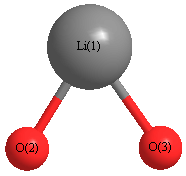Vibrational Frequencies calculated at B2PLYP=FULL/6-311G**
| Mode Number |
Symmetry |
Frequency
(cm-1) |
Scaled Frequency
(cm-1) |
IR Intensities
(km mol-1) |
Raman Act
(Å4/u) |
Dep P |
Dep U |
|---|
| 1 |
A1 |
1100 |
1100 |
7.00 |
1.36 |
0.72 |
0.84 |
| 2 |
A1 |
762 |
762 |
111.84 |
10.24 |
0.20 |
0.34 |
| 3 |
B2 |
536 |
536 |
30.58 |
0.03 |
0.75 |
0.86 |
Unscaled Zero Point Vibrational Energy (zpe) 1198.9 cm
-1
Scaled (by 1) Zero Point Vibrational Energy (zpe) 1198.9 cm
-1
See section
III.C.1 List or set vibrational scaling factors
to change the scale factors used here.
See section
III.C.2
Calculate a vibrational scaling factor for a given set of molecules
to determine the least squares best scaling factor.
